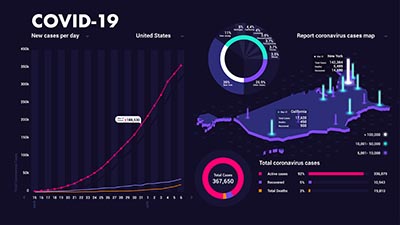About
Project Title
Advancing theory, research, and practice in designing public health data dashboards to better communicate complex information to diverse audiences.
Background and Significance

Public health data dashboards have a significant potential to support sound public health policies and practices because they appeal to a diverse range of users, including policymakers, public health professionals, health care providers, community leaders, and advocates. They are also increasingly recognized for their democratizing potential. This includes making data available to a wider and more diverse range of audiences and ensuring that those who are less privileged and/or are most likely to be impacted by data’s use in decision-making have the power and opportunity to shape how data is used in this context, thereby reframing how we think about health disparities and social determinants of health. As use of public health data dashboards becomes more ubiquitous, it is imperative to proactively consider how such tools may be optimally integrated with data systems and the decision-making routines of key stakeholders. Getting there requires additional investments in the continued development, improvement, and sustainability of public health data dashboards, and a first logical step in this direction is to map and analyze the current ecosystem of public health data dashboards to identify useful practices and point to critical gaps.
Aims and Research Questions
 This project aims to advance theory, research, and practice regarding the future design, implementation, and evaluation of public health data dashboards by systematically mapping and analyzing the current landscape of national public health data dashboards in the U.S. Given that relevant knowledge is dispersed across disciplines and fields that are not in conversation with one another, and that valuable knowledge can be gained from analyzing current applications, landscape mapping can provoke a conversation about where we are, and what we need to move forward. It can also provide direction for the growth and sustainability of these tools by identifying principal actors, relationships, and resources, and linking goals, practices, and outcomes. Key research questions are:
This project aims to advance theory, research, and practice regarding the future design, implementation, and evaluation of public health data dashboards by systematically mapping and analyzing the current landscape of national public health data dashboards in the U.S. Given that relevant knowledge is dispersed across disciplines and fields that are not in conversation with one another, and that valuable knowledge can be gained from analyzing current applications, landscape mapping can provoke a conversation about where we are, and what we need to move forward. It can also provide direction for the growth and sustainability of these tools by identifying principal actors, relationships, and resources, and linking goals, practices, and outcomes. Key research questions are:
- What is the current landscape of national public health data dashboards? Who creates them, for what purpose, with what data, and for whom? Do dashboard creators interact and collaborate?
- What models, policies, rules, and standards are used to create national public health data dashboards, and do they influence creators’ decisions regarding which data are sourced and how data are linked, integrated, and updated?
- What processes and/or frameworks are used for the development, implementation, and evaluation of national public health data dashboards? What are common metrics/indicators for assessing use and impact?
- What design approaches, principles, and features are most frequently incorporated in national public health data dashboards? How may they be associated with the use of these tools?
- What funding and operational models (including staffing structures) are used to develop and maintain national public health data dashboards? What are the most significant costs? What are some best practices, if any, for efficient use of resources?
Approach and Methodology
 The project employs a mixed-methods research approach to answer these research questions, including (1) a scoping review of the interdisciplinary literature on public data dashboards, (2) coding and analysis of public health data dashboards, and (3) a survey of national public health data dashboard creators. The primary focus of these research activities is on actionable public health data dashboards and the three key dimensions of actionability: dashboard data architecture (i.e., models, policies, rules, and standards for acquiring, curating, managing and integrating public health data); dashboard design features (functional, visual, and experiential); and funding and resources (staff, expertise, time, and others) needed to develop, implement, and maintain a national public health data dashboard. A panel of experts (data scientists, data visualization specialists, and public health data dashboard creators) will be engaged to evaluate and provide feedback on all data collection instruments developed, interpretation of findings, and conclusions/recommendations.
The project employs a mixed-methods research approach to answer these research questions, including (1) a scoping review of the interdisciplinary literature on public data dashboards, (2) coding and analysis of public health data dashboards, and (3) a survey of national public health data dashboard creators. The primary focus of these research activities is on actionable public health data dashboards and the three key dimensions of actionability: dashboard data architecture (i.e., models, policies, rules, and standards for acquiring, curating, managing and integrating public health data); dashboard design features (functional, visual, and experiential); and funding and resources (staff, expertise, time, and others) needed to develop, implement, and maintain a national public health data dashboard. A panel of experts (data scientists, data visualization specialists, and public health data dashboard creators) will be engaged to evaluate and provide feedback on all data collection instruments developed, interpretation of findings, and conclusions/recommendations.
Project Deliverables (Open Access)
Project deliverables include: (1) findings of scoping review of the literature on public data dashboards and framework for evaluating public health data dashboards; (2) methodology and instruments for mapping and analyzing national public health data dashboards; (3) list and key characteristics (e.g., creator, funder, data source, indicators/metrics, supported analyses, etc.) of national public health data dashboards in the U.S.; (4) findings of mapping and analysis of the landscape of national public health data dashboards in the U.S.; (5) and findings of survey of national public health data dashboards’ creators.
Funding Source
Support for this research project is provided by the Robert Wood Johnson Foundation. The views expressed here do not necessarily reflect the views of the Foundation.
